Common menu bar links
Breadcrumb Trail
ARCHIVED - National Defence
 This page has been archived.
This page has been archived.
Archived Content
Information identified as archived on the Web is for reference, research or recordkeeping purposes. It has not been altered or updated after the date of archiving. Web pages that are archived on the Web are not subject to the Government of Canada Web Standards. As per the Communications Policy of the Government of Canada, you can request alternate formats on the "Contact Us" page.
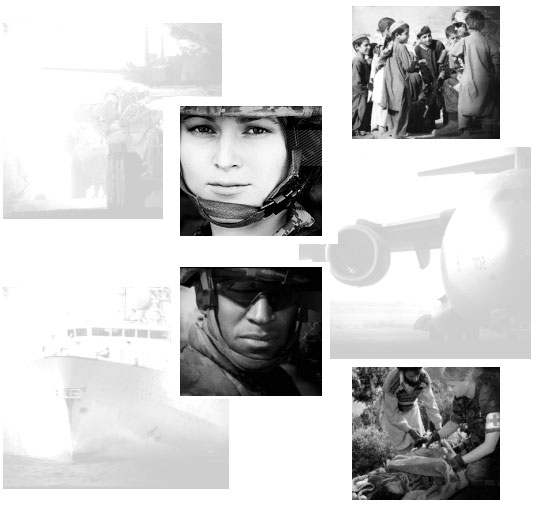

Cover page photos courtesy of www.forces.ca web site.
Hyperlink Notice
The Department of National Defence Departmental Performance Report contains links to third party sites. The Department of National Defence provides these links only as a service and convenience. We take no responsibility for the content at third party sites and a link to them in no way implies an endorsement or recommendation of the products, services or information found there.
A third party site may have a privacy policy different from that of the Department of National Defence. The Department of National Defence disclaims all liability with regard to your access to linked web sites. When you link to sites external to the Department of National Defence departmental Web site, you do so at your own risk.
The Department of National Defence makes every effort to ensure that our links to third party Web sites lead to content that is accessible and available in both official languages. However, that is not always feasible or possible.
MINISTER'S MESSAGE
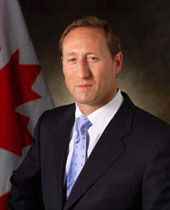
As Minister of National Defence, I am pleased to present to Parliament and the people of Canada the 2008-2009 Departmental Performance Report for the Department of National Defence and the Canadian Forces. Each year, this report provides an opportunity to recognize the achievements and evaluate the challenges faced by the dedicated and highly professional men and women who make up Canada's Defence Team.
The reporting period was marked by a high operational tempo and the release in May 2008 of the Government's detailed roadmap to modernize the Canadian Forces, the Canada First Defence Strategy. We focused on delivering on this long-term plan through expanding the CF while fulfilling our three roles of: delivering excellence at home; being a strong and reliable partner in the defence of North America; and projecting leadership abroad.
On the domestic front, we conducted operations in the North, fulfilling our plan to increase CF presence and exercise our sovereignty. Operation NANOOK, completed in August 2008, tested our ability to respond to humanitarian and environmental emergencies in the region and our capacity to effectively patrol our Arctic air, sea and land approaches. We also started training reserve units to fulfil security tasks and assist in responding to domestic emergencies in the Arctic. Looking to the approaching Vancouver 2010 Olympic and Paralympic Winter Games, we undertook exercises in support of the Royal Canadian Mounted Police-led efforts for the Games.
In the continental context, we continued to work with the United States, including through NORAD, to defend North America. Our men and women in uniform served alongside one another in the NATO-led International Security Assistance Force in Afghanistan as well as in many other international operations. In September 2008, Canada hosted the Conference of the Defence Ministers of the Americas, the singular political forum for promoting security and stability in the Western Hemisphere. As host, Canada reinforced its leadership role in the Hemisphere and made significant advances in security partnerships with key countries.
Internationally, Afghanistan was our main priority. Despite the challenging security context in the country, we responded with success to the many requirements of that whole-of-government mission. Consistent with the recommendations of the 2008 report of the Independent Panel on Canada's Future Role in Afghanistan, Defence delivered unmanned aerial vehicles and helicopters to the CF to improve operational effectiveness and safety.
The ongoing work of our men and women to train the Afghan National Security Forces resulted in strengthened security for the Afghan people and for our civilian partners from other government departments and agencies, 98 of whom served in-theatre at the close-out of the reporting period. From January to the end of March 2009, Canadian security presence was vital in enabling the completion of two new schools in Kandahar province. Elsewhere in the world, the CF provided assistance to missions in Haiti and escorted World Food Programme deliveries to Somalia.
Generating and sustaining military forces to respond to these operational demands remains challenging. While we have improved readiness levels, including training and equipment availability, we will need to continue to carefully manage our resources to ensure the CF can deploy quickly and effectively in response to Government direction.
We also focused on maximizing benefits for Canadians in this difficult economic climate. As we implement the Canada First Defence Strategy, procurement projects will create jobs for our citizens and business opportunities for Canadian companies, including through the Industrial and Regional Benefits program whereby winning contractors are required to undertake business activities in Canada at 100 percent of the contract value. This means that one dollar of economic activity will be generated in Canada for every dollar spent on new fleets of equipment for the CF.
Defence recognizes that personnel are our most valuable resource and that service can demand enormous sacrifices. Since the beginning of the mission until 31 March 2009, 118 Canadians made the ultimate sacrifice and lost their lives in the line of duty in Afghanistan, many others have experienced life-altering injuries. We continue to provide assistance through a number of initiatives to ensure ill or injured CF members, veterans, their families and the families of the deceased receive the care and support they deserve. We are also faced with challenges in recruitment and retention within the CF. Many technical trades are facing a shortage of qualified workers. The demands of a high operational tempo have also upset the balance between the numbers of personnel deployed overseas and those who train new recruits in Canada. We have worked over the past year to implement strategies to help mitigate these trends and know that further work remains ahead of us.
The success of achieving our objectives at home and abroad relies on the essential work performed by the civilian members of the Defence Team. In order to ensure that we have the people we need to perform this important role, we have made Public Service Renewal a priority for Defence and we must continue to strive to attract and recruit the best of Canada's workforce.
Defence's foremost priority is to protect our country - a mission that relies on the dedication of every member of the Defence Team. I look forward to continuing collaboration with Canadians and my colleagues in Parliament to further strengthen DND and the CF and provide unwavering support to our men and women in uniform who courageously defend the safety and interests of all Canadians at home and abroad.
[The original version was signed by]
The Honourable Peter G. MacKay, P.C., M.P.
Minister of National Defence
SECTION I: DEPARTMENTAL OVERVIEW
Introduction
This Departmental Performance Report for the Canadian Forces and Department of National Defence provides an overview of major activities, finance and personnel resource allocations and issues surrounding the delivery of our mandate to the Government of Canada and Canadians. The report provides this information within the broader context of the:
- Canada First Defence Strategy (CFDS) which mandates specific core missions and capability investments;
- The Defence Program Activity Architecture which defines specific Defence strategic outcomes and provides the Department's planning and reporting framework; and
- The Defence priorities which provide areas of specific focus within Defence to which additional effort and, if required, additional resources are allocated to mitigate risks to the delivery of our mandate.
Recurring themes and challenges are highlighted within the report and outline our focus on:
- Caring for our people. Defence is facing the same demographic pressures as the rest of Government and private industry as we plan to replace a significant number of members that will be retiring over the next ten years. We are also committed to providing the best support possible to Canadian Forces members and families. Defence is also working hard to manage personnel capacity constraints while delivering trained forces for operational missions, implementing the Canada First Defence Strategy and addressing the challenges of recruiting Canadians to fill stressed military and civilian occupations;
- Implementing the Canada First Defence Strategy and ensuring success in domestic, continental and international operations. More specifically, Defence is ensuring Canadian Forces (CF) members have the best equipment possible to allow them to perform critical activities in both training and combat roles. This also requires prudent investments in equipment, infrastructure, training and personnel growth;
- Contributing to the security and economic prosperity of Canadian society. Defence provides continuous surveillance of Canada's air, land and maritime approaches and its presence and investments contribute to the economic prosperity of communities and industries across Canada.
Raison d'�tre and Responsibilities
On behalf of the people of Canada, the Canadian Forces stand ready to perform three key roles:
- Defending Canada by delivering excellence at home;
- Defending North America by being a strong and reliable partner with the United States in upholding our continental defence; and
- Contributing to international peace and security by projecting leadership abroad.
The Defence mandate is carried out by the Department of National Defence (DND), the CF and supported by a group of related organizations and agencies. For further details on selected Defence Portfolio organizations, please see Section III: Other Items of Interest - Selected Defence Portfolios.
The National Defence Act1 articulates the foremost responsibility for Defence 2 as the defence of Canada and Canadians. Defence continues to adapt to a dynamic strategic environment, with non-traditional challenges such as piracy, and cyber attacks emerging with traditional ones, including global terrorism proliferation, and the threat of conflict in the Middle East and the Korean Peninsula still enduring. Against the backdrop of an unfolding global financial crisis, challenges such as these will continue to occupy the international agenda and threaten our security and prosperity.
The Canada First Defence Strategy
To help Defence carry out its roles and responsibilities, the Canada First Defence Strategy, released in May 2008, ensures that Canada maintains a first-class, modern military that is well trained, equipped and prepared to meet the challenges of the evolving security environment.
Figure 1: Canada First Defence Strategy

The CFDS articulates the broad strategic vision for Defence, aligned with the level of ambition identified by the Government. The CFDS directs the CF to defend Canada, to enhance the safety and security of Canadians and to support the Government's foreign policy and national security objectives. It outlines six core CF missions in domestic, continental and international contexts:
- Conduct daily domestic and continental operations, including in the Arctic and through the North American Aerospace Defense Command (NORAD);
- Support a major international event in Canada such as the Vancouver 2010 Winter Olympic and Paralympic Games;
- Respond to a major terrorist attack;
- Support civilian authorities during a crisis in Canada such as a natural disaster;
- Lead and/or conduct a major international operation for an extended period; and
- Deploy forces in response to crises elsewhere in the world for shorter periods.
To accomplish this, the CFDS provides a 20-year roadmap to rebuild and modernize the CF with stable and predictable funding that permits long-term planning and investment in four Defence capability areas:
- Personnel: Expansion giving the CF a total Regular/Reserve strength of 100,000 by fiscal year 2027-28;
- Equipment: Renewal of the CF's core equipment platforms;
- Readiness: Improvement of and increase in training for personnel; and
- Infrastructure: Improvement of the overall condition of Defence infrastructure over the long term.
For further information on the Canada First Defence Strategy please visit the following website: www.forces.gc.ca/site/focus/first-premier/index-eng.asp.
Defence Strategic Outcomes and Program Activity Architecture
The Program Activity Architecture (PAA) is mandated by Treasury Board Secretariat as the planning, management and reporting mechanism for Defence. It is broken down into Defence's three strategic outcomes, each supported by a distinct area of program activity, as illustrated below:
Figure 2: Defence Program Activity Architecture
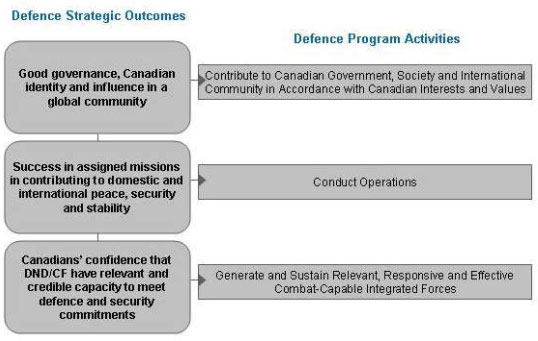
Each Defence strategic outcome and program activity is aligned to one or more of the Government of Canada Outcome Areas including Social, Economic, and International Affairs. For further information, please refer to Section III: Other Items of Interest - Departmental Link to Government of Canada Outcome Areas.
For a full illustration of the Defence PAA, please refer to Section III: Other Items of Interest - Defence Program Activity Architecture. For descriptions of Defence strategic outcomes and associated program activities, please refer to: www.tbs-sct.gc.ca/est-pre/20082009/me-bd/pub/ME-334_e.asp.
The Defence Priorities
The Defence priorities for fiscal year 2008-09 represent a focused number of areas in which Defence planned to direct additional efforts and resources during the reporting period. Defence priorities are reported against the PAA and provide additional means of assessing performance. They do not preclude the allocation of resources to undertakings necessary for the successful execution of the Defence mandate.
In the 2008-2009 Report on Plans and Priorities, Defence identified four priorities to address corporate risks, gaps in capability or capacity and where broader Government direction dictated action be taken during the fiscal year:
- Achieve Operational and Mission Success in Afghanistan;
- Articulate and Implement a New Defence Strategy;
- Improve Defence Team Relevance and Responsiveness through Structure and Process Transformation; and
- Improve the Business and Management of Defence.
For further information pertaining to the relationship between Defence's strategic outcomes, program activities, and the specific initiatives identified to support the advancement of the Defence priorities, please refer to Section III: Other Items of Interest - Relationship between Defence Priorities and Program Activities.
Defence Performance Reporting Framework
The following diagram illustrates the alignment of Defence's PAA and priorities to the CFDS. This framework forms the basis for communicating Defence's performance story throughout this report.
Figure 3: Defence Performance Reporting Framework
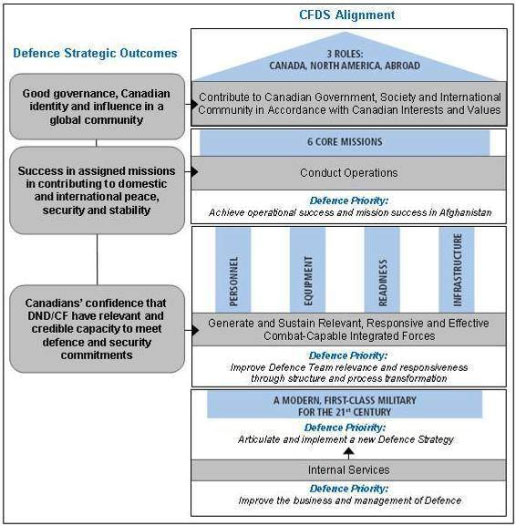
Operating Environment and Risk Analysis
The core of Defence planning during the reporting period focused on the need for a readily deployable and sustainable military capable of meeting Canada's defence requirements and concurrently supporting national and foreign policy objectives.
Defence was influenced by a wide range of factors - both domestic and international - that had an impact on how we carried out our mandate. Those factors presented us with both risks and opportunities which we took into account to deliver on our roles and responsibilities with the utmost success.
Defence's activities continued to be defined by its extensive involvement in Afghanistan. Coupled with domestic initiatives such as support to the Vancouver 2010 Olympic and Paralympic Winter Games as well as Arctic sovereignty, Defence was challenged by the ongoing effort to maintain a sufficient number of trained civilian and military personnel to conduct and support operations, and to support equipment acquisition and sustainment. The Government's commitment to increase Defence funding annually was critical, but fiscal and planning prudence was, and will continue to be, paramount in the face of increasing costs in weapons systems and infrastructure.
Our continuous monitoring of emerging issues, developments and trends allowed us to anticipate and respond to the challenges, mitigate the risks and take advantage of opportunities. Given the nature of the Defence mandate, key considerations in our planning and performance context included:
- Addressing the short-term personnel pressures of high operational tempo;
- Placing a priority on military and civilian personnel, with particular focus where military trades and occupations are considered critical or stressed, and retention activities to sustain Defence;
- Managing our capital procurement activities in collaboration with Industry Canada and Public Works and Government Services Canada to adjust to immediate operational requirements, to accomplish the acquisition goals of the CFDS, and to develop new capabilities to address threats identified by our assessment of the current operational context in Afghanistan and the future security environment;
- Revitalizing the aging real estate portfolio, and managing the growth in infrastructure to support force expansion and equipment acquisition;
- Ensuring the CF is flexible and prepared to deploy in response to Government direction for current near- and long-term national security requirements; and
- Sustaining essential support activities, such as information management and technology, to meet the Department's mandate and invest in the future.
Defence continued to respond effectively to these challenges, and to meet its obligations of operating at home and abroad across the full spectrum of operations, while maintaining close collaboration with our allies.
Performance Highlights
Through the unified efforts of the Defence Team, a number of achievements were made to further progress on Defence strategic outcomes and priorities during a very active period. Guided by the CFDS, the Defence Team delivered on its mandate, conducted core missions and addressed its resource requirements across the four pillars.
A comprehensive assessment of Defence's performance is provided in Section II: Analysis of Program Activities by Strategic Outcomes.
Strategic Outcome: Success in Assigned Missions in Contributing to Domestic and International Peace, Security and Stability
While our immediate security environment remained relatively stable and secure, the Defence Team continued to respond to a number of significant security concerns at home and abroad.
For example, the CF played an important support role to other departments and agencies in responding to numerous challenges, including those resulting from catastrophic environmental events, increased activity in the Arctic, drug trafficking, potential outbreaks of infectious diseases, to providing support for training and preparations for important events in Canada, such as the Vancouver 2010 Olympic and Paralympic Winter Games and the G8 Summit.
Defence continued to place a strong emphasis on Arctic sovereignty. In collaboration with other government departments and agencies, the CF conducted three major exercises that underscore Canada's approach to Arctic sovereignty: Operation Nanook, Operation Nunakput and Operation Nunalivut.
In March 2009, the Government launched the second phase of the Polar Epsilon project. Relying on satellite imagery, this major initiative will greatly improve Canada's surveillance capabilities over the region and other large areas of responsibility. Defence also responded to over 9000 search and rescue requests, coming to the aid of Canadians in dire circumstances and often saving lives. For more information, please see the Section II: Conduct Operations - Domestic and Continental Operations.
On the international front, the proliferation of various categories of weapons and the continued presence of unpredictable regimes posed ongoing challenges to international stability as did ethnic and border conflicts, piracy and global criminal networks. The events of the past clearly demonstrate that these threats can affect our security and that of our allies. In this regard, our mission in Afghanistan continued to be an important contribution to global security.
Defence's activities were heavily shaped by its military contribution to the Afghanistan mission. Every part of the organization contributed to this effort. In line with the whole-of-government approach to operations, Defence worked with the Department of Foreign Affairs and International Trade and the Canadian International Development Agency along with other government departments and agencies to accomplish our common goal of building peace and stabilizing the future of Afghanistan.
Despite the significant resource and operational tempo demands of the Afghan mission and other ongoing commitments, the CF continued to deliver successfully on Canada's commitments to this mission. For more information, please see Section II: Conduct Operations - International Operations.
Strategic Outcome: Canadians' Confidence that DND/CF Have Relevant and Credible Capacity to Meet Defence and Security Commitments
Significant progress was made in all areas following the release of the CFDS.
The effective functioning of the Defence Team - comprised of Regular Force members, Reservists and the civilian workforce - impacts each core mission articulated in the CFDS and affects every priority area for Defence. As such, efforts were directed to integrate more fully the existing corporate planning and monitoring activities while ensuring the Defence Team continues to remain relevant and effective. Increased attrition rates and retirements have placed additional stress on the organization and have necessitated action to mitigate the risk Defence faces in losing critical knowledge and expertise. Action was taken to specify leadership needs, to identify individuals with the potential to assume leadership roles, and to recruit outside the Public Service to expand the pool of qualified applicants. For more information, please see Section II: Generate and Sustain Integrated Forces - The Defence Team.
CF readiness is the method of managing forces in response to commitments, contingencies and projected capability requirements. The army trained required field force units to their designated readiness levels. The navy focused on rebuilding the necessary expertise and capabilities through targeted continental, hemispheric and international engagement plans in response to the CFDS. Yearly Flying Rates (YFR) activities were re-aligned allowing the air force to meet force employment goals. For more information, please see Section II: Generate and Sustain Integrated Forces - Readiness.
In response to a Parliamentary motion to extend the mission in Afghanistan, the CF obtained urgently needed equipment, including six CH-147 Chinook helicopters and 100 Leopard 2 tanks, ahead of schedule and within budget. Key activities related to other CFDS projects, such as the combat vehicles and systems, were initiated in order to secure the required policy approvals and establish the procurement strategies. Investments were directed to modernize the CF's infrastructure and to improve readiness levels. Defence progressed a number of infrastructure initiatives including the completion of interim accommodation for the C-17 aircraft and ramps at 8 Wing Trenton, the construction of three in-service support facilities at Shearwater, Nova Scotia and the completion of a multi-year project to replace ageing and unsafe utilities distribution systems at Gagetown. Defence also advanced the construction of housing and training facilities on bases and wings across the country. For more information, please see Section II: Generate and Sustain Integrated Forces - Equipment and Infrastructure.
Strategic Outcome: Good Governance, Canadian Identity and Influence in a Global Community
The Defence Team made important contributions to Government and to Canadian society in general, as well as to the international community. Examples include efforts to communicate Defence success stories, highlight important aspects of CF history and heritage, lead innovation, enhance research and development, provide a leadership role across Government and play a meaningful role abroad.
Defence worked with federal partners to keep Canadians apprised of the situation in Afghanistan by such means as quarterly progress reports to Parliament and the Afghanistan website. Defence ensured that Canadians were also aware of Canada's rich military history. Defence participated in the 400th Anniversary of the Founding of Qu�bec City and continued to offer guidance and mentorship to young Canadians through the Canadian Cadet Programme and Junior Canadian Rangers Programme. Investments in defence research and development initiatives also benefited Canadian communities. For more information, please see Section II: Contribute to Canadian Government, Society and International Community.
In addition to Canada's contribution to the Afghanistan mission and other international operations, notable events and activities included celebrations of the 50th Anniversary of the North American Aerospace Defense (NORAD) Agreement in April 2008, support to the VIII Conference of Defence Ministers of the Americas in September 2008, and the ongoing work of the Military Training Assistance Program (MTAP). For more information, please see Section II: Contribute to Canadian Government, Society and International Community.
Financial Resources Summary
| 2008-09 | |||
|---|---|---|---|
| Planned Spending | Total Authorities | Actual Spending | |
| Departmental Spending | 18,852,539 | 19,855,430 | 19,184,852 |
| Capital Spending | 3,762,860 | 3,841,144 | 3,297,972 |
The Government of Canada made significant commitments to increase the financial resources available to the Department. As a result, final authority for fiscal year 2008-09 represents an increase of $1B over planned spending.
Financial information is provided throughout the report. For further details, please see Section III: Supplementary Information.
Human Resources Summary
| 2008-09 | |||
|---|---|---|---|
| Planned | Total | Difference | |
| Regular Force | 66,161 | 65,897 | (264) |
| Class C Primary Reserve |
1,400 | 1,596 | 196 |
| Total Military | 67,561 | 67,493 | (68) |
| Total Civilian | 25,000 | 27,305 | 2,305 |
| TOTAL | 92,561 | 94,798 | 2,237 |
Canadians responded to the career opportunities being offered in Canada's military, and Defence continued to gradually build its strength. High operational tempo, and programs and initiatives dedicated to CF transformation and expansion contributed to civilian workforce5 growth of 2,305 FTE personnel. The military Regular Force increased its strength by 1,494 personnel from last year; however, the number of trained effective strength6 personnel increased only marginally by 726 personnel. This marginal increase is due to the fact that most new recruits are currently in the training system and depending on entry program and military occupation, they are expected to reach trained strength status and be fully employable within two to five years.
Reserve Force members have been increasingly called upon to assist Defence in delivering its mandate. An essential component of the Defence Team, the Reserves supported the Regular Force during crises and natural disasters in Canada and provided critical augmentation to respond to dangerous and demanding international missions, most notably in Afghanistan. Approximately 20 percent of the CF contingent in the Afghanistan theatre of operation is comprised of Reservists. In addition, the CF relied heavily on contracting Reserve Force personnel for training duties due to the shortage of Regular Force instructors.
For a complete summary of Defence's financial and human resources, please see: Section III: Other Items of Interest - Summary of Financial and Human Resources.
Contribution of Priorities to Strategic Outcomes
The following present a summary of the progress Defence achieved in pursuing its priorities identified in the 2008-09 Report on Plans and Priorities. Overall, Defence successfully met the commitments it set out for fiscal year 2008-09.
Detailed performance information on the Defence priorities is available in Section III: Other Items of Interest - Contribution of Defence Priorities to Strategic Outcomes.
Type: New
Status: Successfully Met
In close cooperation with other government department partners, Defence has had continued success in meeting its commitments in Afghanistan. Significant progress has been shown toward the achievement of priorities by the ongoing training of Afghan National Security Forces, by the support to the building of Afghan institutional capacity in areas such as health care, and by assistance to democratic elections planned for 2009. Defence also successfully introduced new equipment to support its operations in-theatre and accelerated the introduction of new initiatives to mitigate the physical and mental stress of the mission on CF members and their families.
Linkages to Strategic Outcome(s): This priority is linked to all three strategic outcomes.
Type: New
Status: Successfully Met
The Canada First Defence Strategy was completed and approved in May 2008. Implementation is underway with tangible progress made in new equipment procurement, infrastructure development, personnel growth, and improvements in operational readiness; all of which support the sustainment of Defence's domestic and international commitments.
Linkages to Strategic Outcome(s): This priority is linked to all three strategic outcomes.
Type: New
Status: Successfully Met
The Department has mature processes in place to capture lessons learned from recent experiences at home and abroad. This enables the continuous improvement of the application of military capabilities required to fulfill our roles and responsibilities. As a result, the Defence Team successfully prepared multiple contingents for deployment and expeditiously introduced new equipment into theatres of operation. Improvements to the Operational Commands continued through the creation of a Common Operating Environment - an integrated and synchronized command system that enables decision-making at both the strategic and operational levels. The CF implemented an interim directive on CF readiness and began to introduce a modified method of readiness reporting.
Linkages to Strategic Outcome(s): This priority is linked to the following strategic outcomes:
- Canadians' confidence that DND/CF have relevant and credible capacity to meet defence and security commitments; and
- Success in assigned missions in contributing to domestic and international peace, security and stability.
Type: New
Status: Successfully Met
Treasury Board's Management Accountability Framework assessment for 2008-09 noted that, "the Department should be recognized for exhibiting continued improvement in its management practices". Defence was specifically lauded for the development of its Investment Plan, its exemplary commitment to the whole-of-government team efforts in Afghanistan, and the redesign of its Program Activity Architecture.
Linkages to Strategic Outcome(s): This priority is linked to all three strategic outcomes and relates primarily to the program activity, Internal Services.
Defence experienced capacity issues due to high operational tempo and overall Defence requirements. As a result, efforts were directed to critical priorities and some commitments identified for the 2008-09 fiscal year did not fully progress as planned.
- The Defence Force Structure Review was reprioritized to fiscal year 2009-10. A dedicated team has since commenced review of the current force structure. The initial focus will be to review the CF command and control organizations. The review will examine the demands on personnel resources resulting from our transformational efforts thus far with a goal of ensuring proper balance and efficiency between our headquarter structures and the fighting force.
- The CF was successful in producing a CF Retention Strategy during the fiscal year 2008-09. However, targeted retention initiatives to reduce CF attrition, particularly in stressed military occupations, continue and will remain a focus for years to come. Under a detailed and far-ranging retention strategy, the CF will provide recruits with more realistic early-career expectations, a smoother transition into the military lifestyle and options for addressing physical fitness training requirements. Initiatives aimed at retaining personnel at a later stage in their career include improved career management and greater support of CF families.
- During the fiscal year, the Department successfully prepared an IM/IT Campaign plan to further its enterprise approach to Information Management (IM). A number of initiatives were planned and developed to ready the implementation of an enterprise IM system. These initiatives will continue to progress towards implementation in fiscal year 2009-10 and beyond.
Benefits to Canadians
Defence is positioned strategically in every province and territory: more than 194 Reserve units, 163 Canadian Ranger patrols and 1,136 Cadet units and Junior Ranger patrols further extend our presence to some 3,000 communities across the country, making Defence one of Canada's most visible national institutions.
Figure 4: CF Bases and Wings co-located with civilian service centres across Canada
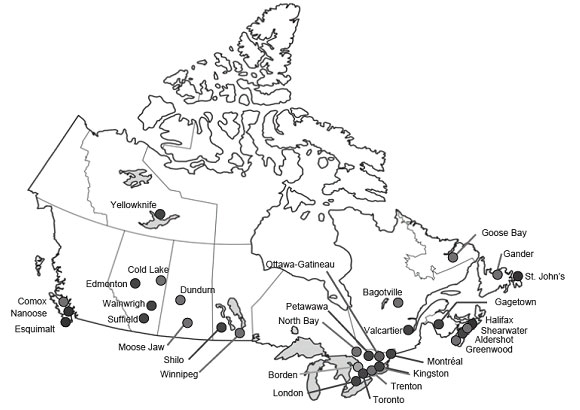
Contribute to Economic Prosperity of Canadian Communities
Defence is contributing to the economic prosperity of Canadian communities in several ways.
Careers with the Canadian Forces are readily available, either full-time as members serving in the Regular Force or part-time as members in the Reserves. The CF offers unlimited career possibilities, exciting challenges and the opportunity to learn new skills. CF personnel belong to air, land, sea and special operations, and work in Canada or abroad.
Nearly 70 types of different civilian career opportunities are available to Canadians in a number of professional, technical and administrative fields. In October 2008, National Defence was recognized by Canadian employment publisher Mediacorp Inc as one of the Top 25 Employers in the National Capital Region for 2009 and one of the best employers for recent graduates.
Defence is also creating jobs through significant investments in equipment and infrastructure projects. In fiscal year 2008-09, Defence invested $495M in capital construction and a further $339M in infrastructure maintenance and repair work projects.
Figure 5: Our Economic Presence 2008-09
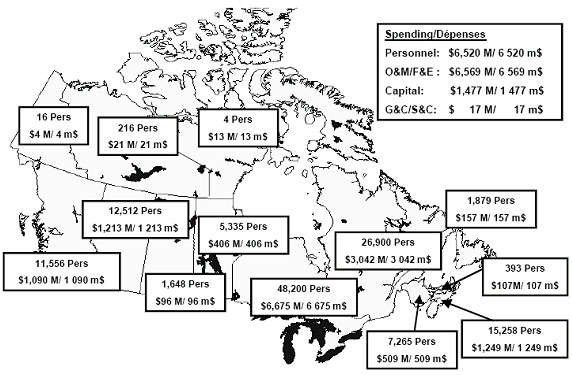
Notes:
- DND expenditures were allocated to provinces based on the postal code of the DND payment recipient.
- Please refer to EDIS publication for details on methodology used in developing DND Estimated Expenditures by Electoral District and Province (EDIS) Fiscal Year 2008-09.
- Personnel numbers includes Regular Force, Civilian and Reserve Force (Primary Reserve) personnel.
- The number of personnel reported in EDIS is not to be interpreted as the number of Full Time Equivalent (FTE) Regular Force, Civilian and Reserve Personnel as reported for fiscal year 2008-09 in the National Defence Departmental Performance Report (DPR). As such, the personnel figures reported in EDIS are likely to be different from the figures reported in DPR.
- The expenditure figures provided are the estimated total gross expenditures for each region in fiscal year 2008-09.
Exemplify Canadian Values and Protect Our Interests
Defence is making important contributions to the safety, security and well-being of Canadians - from protecting citizens and safeguarding Canada's interests and sovereignty, to working with the United States in the defence of North America, and to contributing to international peace and security.
The CF's role in maintaining peace and international stability is inextricably linked to Canadian values and interests. Our prosperity as a nation depends on trade and investment, which in turn both depend on the free movement of people and goods within a stable global framework. The CF contributes to these objectives through a range of activities, by providing security and stability to areas torn by conflict as well as by participating in reconstruction efforts, thereby enabling the creation of viable economies.
Defence exemplifies many values that unite Canadians - the desire to help people in trouble at home and abroad, the pride we take in promoting peace, and our determination to protect and fight for what we believe in.
For further information regarding Defence benefits to Canadians, please refer to Section II: Analysis of Program Activities by Strategic Outcomes - Benefits to Canadians.
Expenditure Profile
| Departmental Spending ($thousands) |
|||||
|---|---|---|---|---|---|
| 2006-07 Actual Spending |
2007-08 Actual Spending |
2008-09 | |||
| Main Estimates | Planned Spending | Total Authorities | Actual Spending | ||
| 15,682,631 | 17,524,049 | 18,293,756 | 18,852,539 | 19,855,430 | 19,184,852 |
Over the last three years, significant financial resources were provided to support the annual goals for Force Expansion, to replace and acquire new capital equipment, to improve overall readiness and to meet the required infrastructure maintenance, repair and construction activities.
In 2008-2009, the Main Estimates were increased through Supplementary Estimates and allotments from Treasury Board by $1,561.7 million. The difference of about $670 million between the total authorities and the actual spending is composed primarily of $538.6 million related to capital projects that will be returned to the department in future years, in accordance with the specific project cash flow schedules, and $100.8 million of Operating Budget Carry-Forward funding that will be returned to the department in 2009-2010.
In 2008-2009, the actual spending increased significantly as a result of related funding received to cover the incremental costs for the mission in Afghanistan, the growth of the forces (pay and related allowances), but more specifically, capital equipment funding increases resulting from the use of accrual budgeting practices of Budgets 2005 and 2006. Budgetary funding from Budgets 2005 and 2006 allowed the Department, in a short time, to make significant investments in its Capital program.
Financial Spending Trend
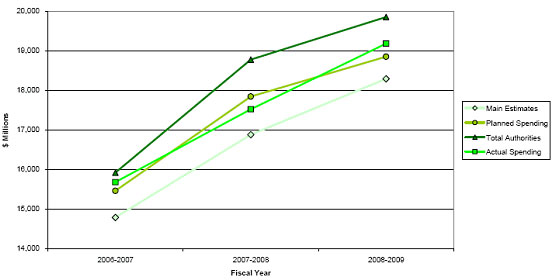
Note: The following briefly explains the timing of the information provided in the Financial Spending Trend chart above:
- The "Main Estimates" figure is submitted in December, prior to the start of a new fiscal year. It includes the known approved level of funding for the department as of October.
- The "Planned Spending" provides an update of the Main Estimates information on additional funding approved between October and February, as well as expected funding to be approved in the new fiscal year for which Treasury Board Secretariat has approved disclosure.
- The "Total Authorities" represents the final authority as shown in the Public Accounts. This figure represents the final level of approved funding.
- The "Actual Spending", also found in the Public Accounts, represents the final spending on a cash basis.
Expenditure Management Review
The Department complied with the Expenditure Review Committee (ERC) program efficiency targets for fiscal year 2008-09. This marked the fourth year of ERC reductions, as Defence proceeded toward the final steady-state reductions in fiscal year 2009-10. For further details, please see Section III: Other Items of Interest - Expenditure Management Review.
Voted and Statutory Items
($ Thousands)
This table explains the way Parliament votes resources to National Defence in a standardized fashion. It reflects the changes made throughout the fiscal year to funding levels via Supplementary Estimates, allotments from Treasury Board and reallocations resulting from changing priorities and operational pressures. In addition, it reflects the actual spending for those votes for the current and past two fiscal years.
| Vote (1, 5, 10) or Statutory Item (S) | Truncated Vote or Statutory Wording |
2006-07 Actual Spending |
2007-08 Actual Spending |
2008-09 Main Estimates |
2008-09 Total Authorities |
2008-09 Actual Spending |
|---|---|---|---|---|---|---|
| 1 | Operating expenditures | 11,925,235 | 12,812,314 | 13,519,620 | 14,381,794 | 14,283,787 |
| 5 | Capital expenditures | 2,381,824 | 3,199,760 | 3,356,705 | 3,841,144 | 3,270,903 |
| 10 | Grants and contributions | 187,350 | 168,793 | 192,396 | 193,833 | 191,834 |
| 11 | Pursuant to section 24.1 of the Financial Administration Act, to forgive a debt due by Mr. R.P. Thompson to Her Majesty in Right of Canada amounting to $1,766.11 - To authorize the transfer of $1,766 from National Defence Vote 1, Appropriation Act No. 1, 2006-2007, for the purposes of this Vote. | 2 | N/A | N/A | N/A | N/A |
| 12 | Pursuant to section 24.1 (1) (b) of the Financial Administration Act, to forgive a debt due by Parc Downsview Park Inc. to Her Majesty in Right of Canada amounting to $15,059,000 | 0 | N/A | N/A | N/A | N/A |
| (S) | Minister of National Defence salary and motor car allowance | 73 | 74 | 76 | 77 | 77 |
| (S) | Payments under the Supplementary Retirement Benefits Act | 6,796 | 6,079 | 6,796 | 5,459 | 5,459 |
| (S) | Payments under Parts I-IV of the Defence Services Pension Continuation Act | 1,493 | 1,319 | 1,493 | 1,159 | 1,159 |
| (S) | Payments to dependants of certain members of the Royal Canadian Air Force killed while serving as instructors under the British Commonwealth Air Training Plan (Appropriation Act No. 4, 1968) | 80 | 80 | 82 | 82 | 82 |
| (S) | Contributions to employee benefit plans - Members of the Military | 905,145 | 1,056,614 | 938,132 | 1,106,655 | 1,106,655 |
| (S) | Contributions to employee benefit plans | 254,004 | 269,730 | 278,456 | 292,857 | 292,857 |
| (S) | Spending of proceeds from the disposal of surplus Crown assets | 20,591 | 9,242 | N/A | 32,329 | 31,998 |
| (S) | Collection Agency Fees | 39 | 44 | N/A | 40 | 40 |
| Total Department | 15,682,631 | 17,524,049 | 18,293,756 | 19,855,430 | 19,184,852 | |
Source: Assistant Deputy Minister (Finance and Corporate Services) Group
Notes:
- The total spending difference of $1,661 million between fiscal years 2007-08 and 2008-09 is attributed to an increase of $327.2 million for military pay and allowances; $245.3 million for engineering and other professional services; $209.3 million for the purchase and rental of aircraft, and aviation fuel; $171.6 million for civilian pay and allowances; $143.2 million on vehicles and other equipment; $125.3 million on travel and relocation; $87.0 million for materials and supplies; and $162.6 million over a diverse area of other spending.
- 2008-2009 Spending Authority was increased through Supplementary Estimates and allotments from Treasury Board by $1,561.7 million for the following: $557.3 million for the Tactical Airlift Capability project; $331.0 million for the mission in Afghanistan; $236.6 million to cover the costs of military pay and allowance increases; $200.0 million as a result of the Department's operating budget carry-forward from 2007-2008 to 2008-2009; $137 million to cover the costs of civilian pay and allowance increases; $54.6 million for the Halifax Class Frigate Modernization and Life Extension project; and net $45.2 million increase to cover other miscellaneous items.
